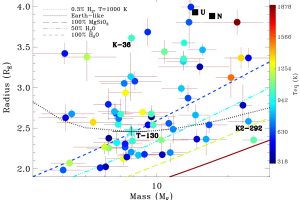Composition of a sub-neptunian exoplanet with TESS and ESPRESSO. The study: “A sub-Neptune and a non-transiting Neptune-mass companion unveiled by ESPRESSO around the bright late-F dwarf HD 5278 (TOI-130)” of A. Sozzetti (INAF-OATo) recently appeared on A&A

The NASA satellite Transiting Exoplanet Survey Satellite (TESS) it’s one of the most effective telescopes to search for exoplanets. TESS is designed to find exoplanets with the transits method, e.g. by observing the periodic occultations of stars by their planets during their orbits. To date, about 27% of the exoplanets discovered with TESS belong to the class of the sub-neptunians. These planets have a radius of 2-4 Earth radii, and they are not present in the Solar System. For this reason, the study of sub-neptunians, their formation, and their composition is one of the most important topics in the exoplanetary science.
Exoplanets compositions is typically estimated from their density, which is in turn found from their mass and volume. Planetary mass is derived from the radial velocity of their stars, e.g. from the amplitude of the oscillations of each star around their rest position due to the gravitational attraction and rotation of their planets; volume is instead estimated from the transits. However, for sub-neptunian planets this is often not enough. It has been shown, in fact, that, mainly when they are in close orbits around their star, sub-neptunian planets are not rocky planets, but they retain a large amount of volatiles. To date, several models have been proposed to explain the composition of sub-neptunian exoplanets and their atmospheres.
The team of researchers led by the astronomer Alessandro Sozzetti (INAF – Osservatorio Astrofisico di Torino) analyzed 43 spectroscopic observations acquired with ESPRESSO, mounted on the Very Large Telescope of the European Southern Observatory, and TESS observations of the star TOI-130 (HD 5278). This star is a F type star, at a distance of about 185 light years from us, known to host a sub-neptunian planet. As described in the paper “A sub-Neptune and a non-transiting Neptune-mass companion unveiled by ESPRESSO around the bright late-F dwarf HD 5278 (TOI-130)“, recently appeared on Astronomy & Astrophysics, the joint analysis of TESS and ESPRESSO data allowed the astronomers to estimate both the mass of HD 5278 b (7.8 Earth masses), its radius (2.45 Earth radii), and thus to derive the planet mean density (2.9 g/cm3). By comparing this estimate to models predicting sub-neptunians structure, the researchers concluded that HD 5278 b is a planet rich in water (about 30% of its mass), and it also has an rich atmosphere which contains about 0.4% of the planets mass and it extends for about 7% of its radius. The analysis of the ESPRESSO spectra also revealed the presence of another exoplanet in the system, with a period of 41 days and a minimum mass of 18.4 Earth masses. Among the coauthors, the astronomer G. Micela of INAF – Astronomical observatory of Palermo.
The image (click here to visualize the entire figure) shows a scatter plot mass vs. radius of all known sub-neptunian exoplanets discovered so far. The different colors mark the planets equilibrium temperatures. The different curves depict several models describing the internal structure of sub-neptunian exoplanets. In the diagram, also the positions of Uranus, Neptune, HD 5278 b, and the exoplanets K-36 b e K2-292 b are shown.
